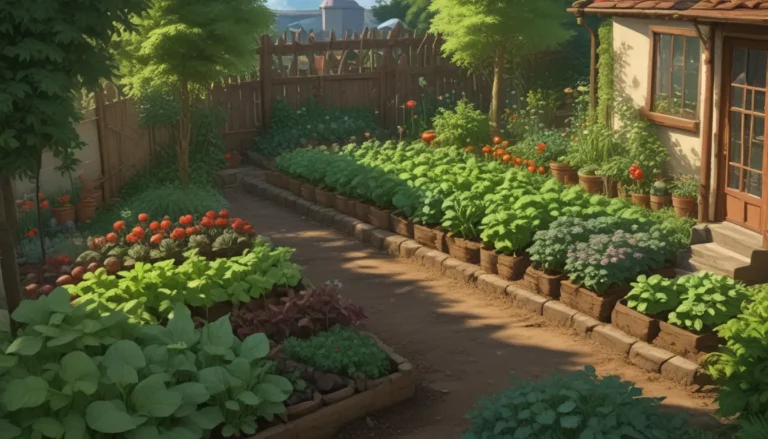How to Prepare Your Garden for a Flourishing Spring Season

Ah, spring – the season of new beginnings in the garden. It’s a time full of hope, excitement, and the promise of colorful flowers and delicious vegetables to come. If you’re like me, you’re eagerly anticipating the longer days and warmer weather that signal the start of the growing season.
Before you can fully enjoy the beauty of your garden, there are some crucial steps to take to prepare. From planning and seed starting to infrastructure maintenance and bed preparation, getting your garden ready for spring is key to a successful growing season.
In this comprehensive guide, we’ll walk you through everything you need to do to ensure your garden is primed and ready for spring:
Preparing Your Garden for a Bountiful Spring
- Plan Your Garden
- Buy and Start Seeds
- Build or Repair Infrastructure
- Prepare the Beds
- Prune and Remove Dead Material
- Remove Old and Add Fresh Mulch
- Divide and Transplant Perennials
- Clean Tools and Organize Storage
- Sort Out Compost
1. Plan Your Garden
Before you start digging in the dirt, take some time to plan out your garden. Make a list of what you want to grow, where you want to plant each species, and when to start seeds indoors or outdoors.
Consider the following points when planning your garden:
- Keep a gardening journal to track your progress and stay organized.
- Walk around your garden to make notes on what needs to be done.
- Determine which seeds need to be started indoors and when.
2. Buy and Start Seeds
Timing is crucial when it comes to seed starting. Make sure you order your seeds in advance and start sowing them according to the specific requirements of each plant.
Remember:
- Start seeds indoors six to eight weeks before the last frost date.
- Allow additional time for slow-growing seeds and hardening off.
- Consider shipping times if ordering seeds online.
3. Build or Repair Infrastructure
Assess your garden infrastructure and make any necessary repairs or upgrades. Pay special attention to light exposure, as it can greatly impact plant growth.
Check for:
- Damaged fences, trellises, and raised beds.
- Clean out drainage channels and gutters.
- Ensure optimal light exposure for your plants.
4. Prepare the Beds
Healthy soil is the foundation of a successful garden. When preparing your beds, focus on improving soil quality and texture by incorporating compost and mulch.
Remember to:
- Wait until the soil is workable to prevent compaction.
- Remove weeds, till the soil, and add compost.
- Top the soil with mulch for added protection and moisture retention.
5. Prune and Remove Dead Material
Spring is the perfect time to clean up your garden and remove any dead or decaying plant material. Pruning trees, shrubs, and perennials will encourage healthy growth and flowering.
Don’t forget to:
- Prune off broken or dead branches.
- Remove old seed heads and withered foliage.
- Weed out unwanted seedlings and plants.
6. Remove Old and Add Fresh Mulch
As the weather warms up, remove old mulch and replace it with fresh organic mulch. Mulch helps suppress weeds, retain moisture, and protect plant roots.
Consider using:
- Shredded bark, wood chips, grass clippings, or compost.
- Avoid excessive mulch thickness around underground plants.
- Spread mulch evenly throughout the bed for best results.
7. Divide and Transplant Perennials
Spring is an ideal time to divide and transplant perennials to rejuvenate your garden. By dividing plants like daylilies and hostas, you can increase your plant stock and promote healthy growth.
Key tips for dividing perennials:
- Use two forks to gently pry apart root systems.
- Water freshly planted divisions to prevent transplant shock.
- Divide bulbs and rhizomes for optimal growth.
8. Clean Tools and Organize Storage
Maintaining clean tools is essential for preventing the spread of pathogens in your garden. Take the time to sanitize, sharpen, and organize your gardening tools and storage area.
Remember to:
- Wipe down tools with a bleach solution.
- Sharpen blades for precision cutting.
- Organize storage space for easy access during the growing season.
9. Sort Out Compost
Revitalize your compost pile by adding fresh materials and turning it regularly. Covering the pile protects it from spring rain and accelerates the composting process.
Key composting tips:
- Add chopped leaves, lawn clippings, or straw to aerate the pile.
- Turn the compost weekly to promote decomposition.
- Learn more about composting best practices for a healthy garden.
Embrace Spring and Enjoy Your Garden
By following these comprehensive steps to prepare your garden for spring, you’ll set yourself up for a successful growing season. Taking the time to plan, seed, and nurture your garden will yield beautiful blooms, delicious vegetables, and a thriving outdoor space.
What are you most looking forward to planting this year? Share your gardening plans in the comments below! Happy gardening!
I hope this guide has equipped you with the knowledge and inspiration to kickstart your spring garden preparations. For more seasonal gardening tips and insights, explore our related guides:
- 11 Things to Do in the Garden Before Winter
- How to Plant an Autumn Vegetable Garden
- How to Survive Jack Frost: Prepping Your Trees for Winter
Happy gardening!
*





